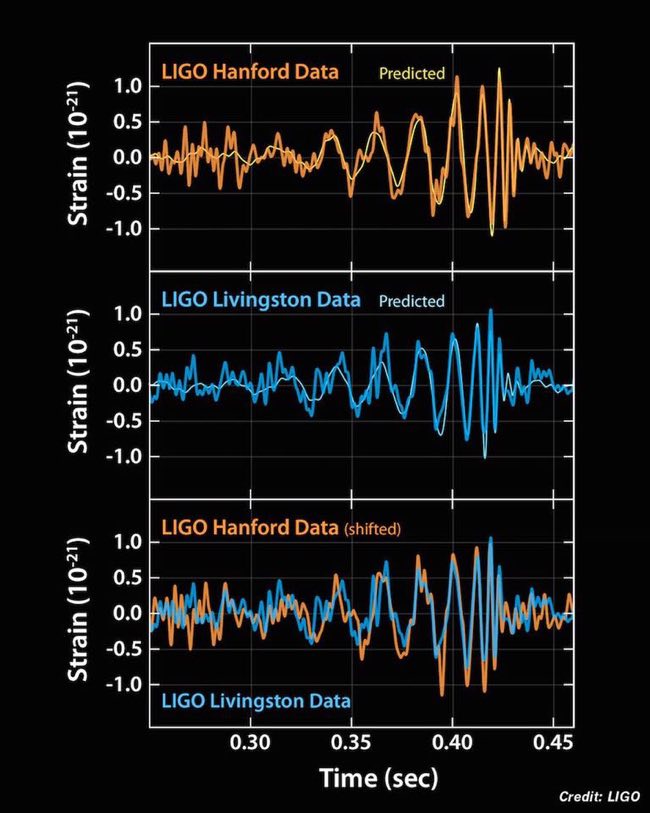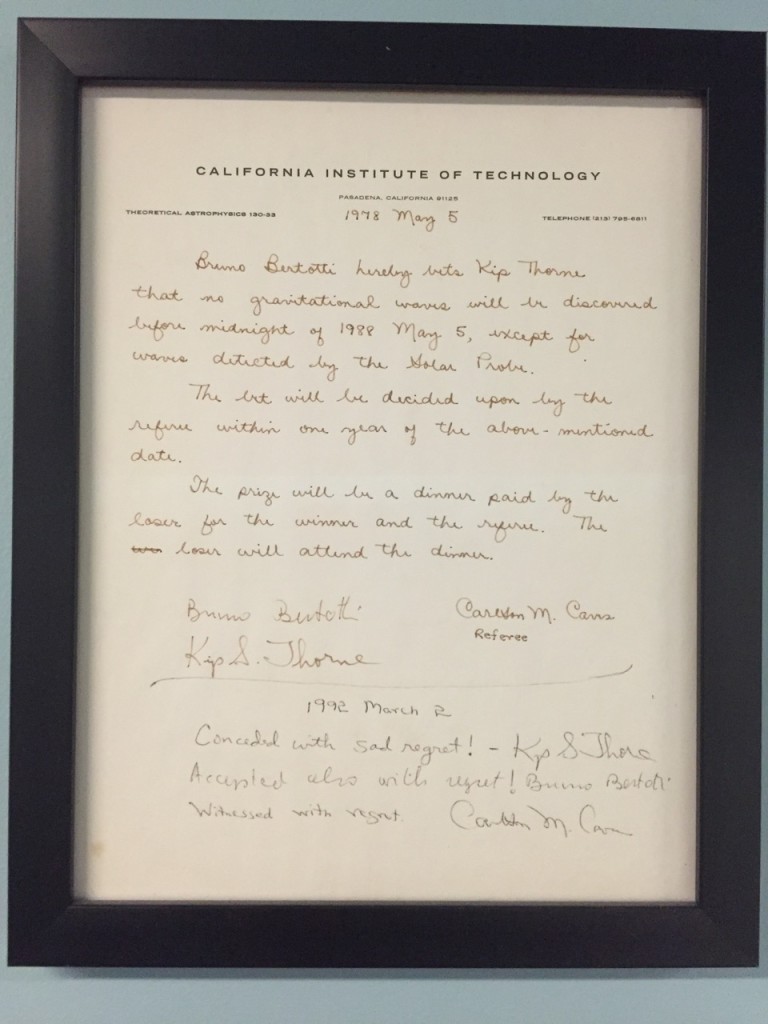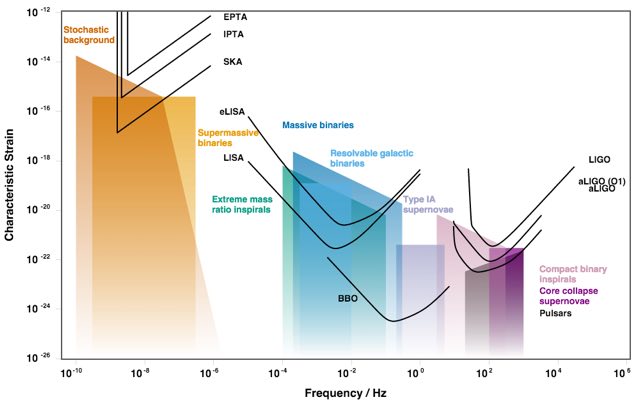ONCE upon a time, there lived a man who was fascinated by the phenomenon of gravity. In his mind he imagined experiments in rocket ships and elevators, eventually concluding that gravity isn’t a conventional “force” at all — it’s a manifestation of the curvature of spacetime. He threw himself into the study of differential geometry, the abstruse mathematics of arbitrarily curved manifolds. At the end of his investigations he had a new way of thinking about space and time, culminating in a marvelous equation that quantified how gravity responds to matter and energy in the universe.
Not being one to rest on his laurels, this man worked out a number of consequences of his new theory. One was that changes in gravity didn’t spread instantly throughout the universe; they traveled at the speed of light, in the form of gravitational waves. In later years he would change his mind about this prediction, only to later change it back. Eventually more and more scientists became convinced that this prediction was valid, and worth testing. They launched a spectacularly ambitious program to build a technological marvel of an observatory that would be sensitive to the faint traces left by a passing gravitational wave. Eventually, a century after the prediction was made — a press conference was called.
Chances are that everyone reading this blog post has heard that LIGO, the Laser Interferometric Gravitational-Wave Observatory, officially announced the first direct detection of gravitational waves. Two black holes, caught in a close orbit, gradually lost energy and spiraled toward each other as they emitted gravitational waves, which zipped through space at the speed of light before eventually being detected by our observatories here on Earth. Plenty of other places will give you details on this specific discovery, or tutorials on the nature of gravitational waves, including in user-friendly comic/video form.
What I want to do here is to make sure, in case there was any danger, that nobody loses sight of the extraordinary magnitude of what has been accomplished here. We’ve become a bit blasé about such things: physics makes a prediction, it comes true, yay. But we shouldn’t take it for granted; successes like this reveal something profound about the core nature of reality.
Some guy scribbles down some symbols in an esoteric mixture of Latin, Greek, and mathematical notation. Scribbles originating in his tiny, squishy human brain. (Here are what some of those those scribbles look like, in my own incredibly sloppy handwriting.) Other people (notably Rainer Weiss, Ronald Drever, and Kip Thorne), on the basis of taking those scribbles extremely seriously, launch a plan to spend hundreds of millions of dollars over the course of decades. They concoct an audacious scheme to shoot laser beams at mirrors to look for modulated displacements of less than a millionth of a billionth of a centimeter — smaller than the diameter of an atomic nucleus. Meanwhile other people looked at the sky and tried to figure out what kind of signals they might be able to see, for example from the death spiral of black holes a billion light-years away. You know, black holes: universal regions of death where, again according to elaborate theoretical calculations, the curvature of spacetime has become so pronounced that anything entering can never possibly escape. And still other people built the lasers and the mirrors and the kilometers-long evacuated tubes and the interferometers and the electronics and the hydraulic actuators and so much more, all because they believed in those equations. And then they ran LIGO (and other related observatories) for several years, then took it apart and upgraded to Advanced LIGO, finally reaching a sensitivity where you would expect to see real gravitational waves if all that fancy theorizing was on the right track.
And there they were. On the frikkin’ money.
Our universe is mind-bogglingly vast, complex, and subtle. It is also fantastically, indisputably knowable.

I got a hard time a few years ago for predicting that we would detect gravitational waves within five years. And indeed, the track record of such predictions has been somewhat spotty. Outside Kip Thorne’s office you can find this record of a lost bet — after he predicted that we would see them before 1988. (!)
But this time around I was pretty confident. The existence of overly-optimistic predictions in the past doesn’t invalidate the much-better predictions we can make with vastly updated knowledge. Advanced LIGO represents the first time when we would have been more surprised not to see gravitational waves than to have seen them. And I believed in those equations.
I don’t want to be complacent about it, however. The fact that Einstein’s prediction has turned out to be right is an enormously strong testimony to the power of science in general, and physics in particular, to describe our natural world. Einstein didn’t know about black holes; he didn’t even know about lasers, although it was his work that laid the theoretical foundations for both ideas. He was working at a level of abstraction that reached as far as he could (at the time) to the fundamental basis of things, how our universe works at the deepest of levels. And his theoretical insights were sufficiently powerful and predictive that we could be confident in testing them a century later. This seemingly effortless insight that physics gives us into the behavior of the universe far away and under utterly unfamiliar conditions should never cease to be a source of wonder.
We’re nowhere near done yet, of course. We have never observed the universe in gravitational waves before, so we can’t tell for sure what we will see, but plausible estimates predict between one-half and several hundred events per year. Hopefully, the success of LIGO will invigorate interest in other ways of looking for gravitational waves, including at very different wavelengths. Here’s a plot focusing on three regimes: LIGO and its cousins on the right, the proposed space-based observatory LISA in the middle, and pulsar-timing arrays (using neutron stars throughout the galaxy as a giant gravitational-wave detector) on the left. Colorful boxes are predicted sources; solid lines are the sensitivities of different experiments. Gravitational-wave astrophysics has just begun; asking us what we will find is like walking up to Galileo and asking him what else you could discover with telescopes other than moons around Jupiter.
For me, the decade of the 2010’s opened with five big targets in particle physics/gravitation/cosmology:
- Discover the Higgs boson.
- Directly detect gravitational waves.
- Directly observe dark matter.
- Find evidence of inflation (e.g. tensor modes) in the CMB.
- Discover a particle not in the Standard Model.
The decade is about half over, and we’ve done two of them! Keep up the good work, observers and experimentalists, and the 2010’s will go down as a truly historic decade in physics.



@ Jeff H The shifting is due to the delay in detection between the two detectors, which if the signal was coming from a source directly in the line of the two would be ~10ms light speed delay. The sign flip is probably due to the relative orientations of the two detectors like you said, but that I’m only guessing.
On the topic of gravitons, this says nothing about whether they exist, but according to Kip Thorne in the livestream event this puts an upper-bound on the graviton mass at 10E-55 g (or 10E-23 eV). I believe to be fully in accordance with GR gravitons would be massless.
Maybe this will help keep the funding for the NSF. But knowing Congress I wouldn’t count on it. More could have been discovered with LISA. But that was cancelled by NASA. Fortunately the Europeans are taking up the slack with eLISA. Nonetheless, kudos to those who have worked so hard with LIGO. It’s a gold star for Big Science in America.
James Goetz says:
February 11, 2016 at 10:22 am
“I have a question with some background context. For example, I suppose that “2. Directly detect gravitational waves” is tantamount to “5. Discover a particle not in the Standard Model.” In other words, I suppose that the direct detection of gravitational waves is the direct detection of gravitons that are not in the Standard Model. ”
Gravity is not part of the Standard Model.
In an earlier comment I questioned whether the impact of the gravitational wave packet upon the laser beam itself ( it’s wavelength or phase) needed to be accounted for, in addition to the alterations in interferometer lengths along the two arms. I think I have found a good way of looking at it for those who have Sean’s book “Spacetine and Geometry: An Introduction to General Relativity”. His Eq. (7.202) gives an expression for the accumulated phase shift due to the delta(L) path length variation caused by the gravitational wave packet. The expression involves the laser wavelength. If one inserts an assumed perturbation to the wavelength of [1+delta(L)/L] (like I suggested) it turns out to only produce a second order effect upon the accumulated phase shift. That is, a term of order [delta(L)/L]**2 results, which is negligible. I hope I got that right.
Is there such a thing or predicted thing as a force carrier for gravitational waves?
A lowly layman´s question: Would the discovery of gravitational waves, and hopefully the further array of many more detectors, give astrophysicists the possibility of better understanding and locating past ULX events and their enormous gamma”rave” outbursts? Do such phenomena ever emit enough energy to produce such waves? It is my (very limited) understanding that in such events the structure of carbón is transformed into a form which precludes the possibilty of life emerging in large areas of such events, and were they found to have been more common in the past, narrow significantly the galaxies or galactic areas in which cabon based life might have arisen and thereby the overall possibility of carbon-based life elsewhere in the universe. Are these even valid questions to begin with?
Charming presentation! cheers to the further proof of our universe being unified and uniform.
Hi James Goetz,
“Gravitational waves are also called “gravitational ripples” and and are not the waves/vibrations of theoretical gravitons.”
I don’t see why not, at least on the surface of it. EM radiation is caused by accelerating electric fields and gravitational waves are produced by accelerating gravitational fields, so why, by analogy, are these not the waves of theoretical gravitons?
Though I realise the analogy does break down because if there is a wave that is the probability of there being a graviton at a particular position that wouldn’t make sense, because position itself is a function of gravity.
I would be interested in someone who knows something about these theories commenting on this.
Having thought about this some more, I’ve realised some confusion on my part arose throught thinking of LIGO as an experiment, which it is not – it’s a detector, a piece of engineering apparatus. Which is fine, but my discomfort with the LIGO setup is this: How do you calibrate this detector, given that you can’t expose it to the object of its detection (i.e. gravitational waves) in any sort of controlled way? This seems to me a hard problem which hasn’t been explained to my satisfaction.
But the proof of the pudding will be in the eating. If future detections lead to interesting new science then LIGO will start to prove itself worthwhile.
Wiseape – The reason that gravitational waves travel at the speed of light is that gravitation has an inverse square dependence. If they traveled more slowly, gravitons would have rest mass, and gravity would fall off more rapidly than that. The same logic is what causes light to move at the speed of light – the inverse square law dependence of the electromagnetic force. A deeper understanding of this requires looking at the form of the basic equations.
@Richard Mology – Calibrating a measuring device such as this is a pretty tricky task, so you are right to be curious. One of the companion papers (http://arxiv.org/abs/1602.03845) to the detection announcement was on the effort to calibrate various important components of the instrument. Sadly the project doesn’t have any way (yet) to calibrate the instrument purely via gravity.
Suffice to say, while there are a number of methods to make such measurements, the primary (& best) method is to differentially actuate on the mirrors with a secondary laser system. While not wholly equivalent to the strain produced by a passing gravitational wave, the resulting interference pattern at the output photo-diode is as close as one can get. If you know how much laser power hits and reflects from the mirror along with the mirrors moments of inertia, you can work how far it moves from all those photons as a function of frequency.
I’m guessing that the gravitational wave/ripple caused fluctuation in both space and time. Is that correct? Also, is there an upper limit on how much spacetime fluctuation that a gravitational wave can cause?
@Joaquin
I was also confused about that. Turns out the answer is that the laser used has a fairly large spot size, so it’s averaging over something like 10^23 atoms when it hits the mirror, and the random thermal motion of all those atoms ends up cancelling out.
it appears to me that the sheet of space-time has been illustrated in two dimensions? instead of three (or even four?) as it should be……..
“it appears to me that the sheet of space-time has been illustrated in two dimensions? instead of three (or even four?) as it should be……..”
First, think about whether it should be two or three. Then, feel free to draw your representation on a two-dimensional surface.
Though the topic of discussion is gravitational wave, I think it is reasonable to say something about the reconciliation of general relativity and quantum mechanics since this will reveal more facts about gravitational wave. Many notable ideas have been put forwards to reconcile these theories. Prominent among them is string theory..Recently, myself and my collaborators have been working on an idea that has enabled us to reinterpret the wave nature of matter , making it compatible with the requirement of general relativity. This idea leads to a new dimension. With this dimension and an appropriate Lagrangian, larmor for power radiated by a point charge is obtained.
We believe this idea may reconcile general relativity and quantum mechanics